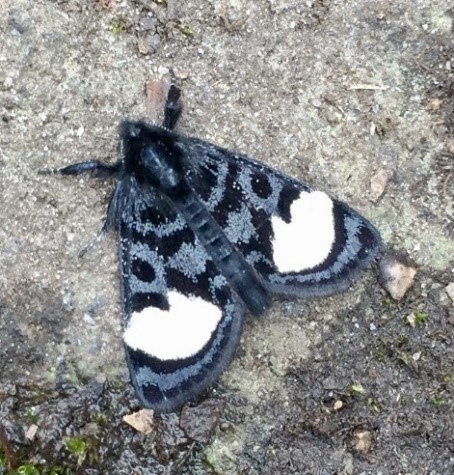
The Pandorus Sphinx Moth with wing span of 3 ½ inches
Did you know there are more than 12,000 species of moths in North America? As the majority of them are active at night, we rarely see them. In contrast, there are about 765 species of North American butterflies. While moths and butterflies belong to the same order of Lepidoptera, moths are a much older species. They appeared about 300 million years ago, while butterflies evolved about 200 million years later.
Moths can be identified by their furry bodies and feathered antennae. Butterflies have smooth bodies and straight antennae with a knob at the end. When at rest, moths hold their wings horizontally like airplane wings, while butterflies rest with their wings folded vertically above their bodies.


This Grapevine Moth (left) is the size of a dime; the Pale Beauty Moth (right) is slightly enlarged
Moths come in all sizes and colors though most are shades of brown or white. They often have mottled patterns which help them blend in with their surroundings. Other markings, such as the giant eyespots seen on the Polyhemus Moth, may ward off predators and provide an extra measure of safety.
Moths visit flowers to drink nectar which is a source of energy. While they do not actively collect pollen, their hairy bodies pick up pollen granules and spread them around as they move from flower to flower, thus aiding in pollination. About three-fourths of moth species are nocturnal. They are attracted to night-blooming flowers which are mostly white or cream-colored and strongly scented, which makes them easier to locate in the dark. Some of the species that forage during the day include silk and hummingbird moths and tiny mint moths.

The hairy body and feathered antennae are visible on this Confused Eusarca Moth

Underwing Moth highly visible on milled wood

Underwing Moth camouflaged on hemlock bark

Polyphemus Moth with fake eye spots


(L) Hummingbird Moths hover above flowers and probe for nectar with their long tongues, much like hummingbirds. (R) An Orange Mint Moth on mountain mint. They are also feed on catmint, calamint, marjoram, and thyme.

Host plants for the Brown Hooded Owlet Moth caterpillars are goldenrods and asters. The 1st generation of the season eats the leaves and the 2nd generation munches on the flowers
Moths undergo true metamorphosis, meaning they pass through four stages of development: from egg to larva (caterpillar) to pupa (chrysalis) to adult. The eggs hatch into caterpillars which eventually spin cocoons and transform into adults.
As with butterflies, moths have evolved with specific host plants, the only ones their caterpillars can digest. The females must locate these plants in their habitats before they can lay their eggs. Host plants range from wildflowers to understory shrubs to small, canopy trees native to our region. Native is key as most alien species do not benefit our insect populations.
In addition to their role as pollinators, moths fill an important link in our natural food webs. Their caterpillars feed the animal kingdom. Songbirds raise their young principally on caterpillars. Frogs, toads, and salamanders prey on them, as do chipmunks, squirrels, foxes, and most other mammals living in our New England habitats.
Protected natural open spaces are essential to the survival of moths and other insect species. On the home front, we can all help simply by leaving parts of our property wild and undisturbed, adding more native plants, avoiding the use of pesticides and systemic fertilizers, and turning off outside lights which are often fatal to night fliers.
Moths and their caterpillars are just as interesting as butterflies and there are so many more kinds of them to discover. Keep a look out!

Host plants for the White-marked Tussock Moth caterpillar include many species of native trees such as oak, elm, basswood, sycamore, fruit trees, and even roses. The spines on this type of caterpillar can cause skin rashes, and they should be admired from afar.
Recent Comments